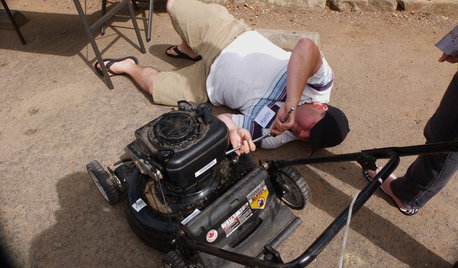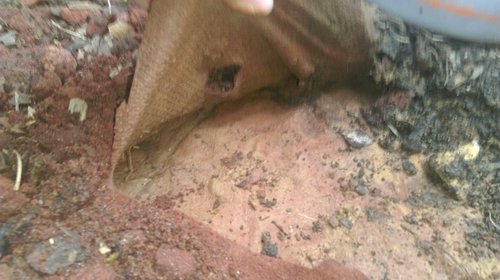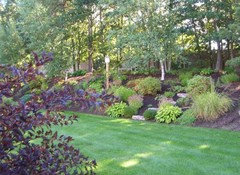Don't ever use weed cloth. Just don't do it.
theparsley
7 years ago
Featured Answer
Sort by:Oldest
Comments (54)
nancyjane_gardener
7 years agorayzone7
7 years agolast modified: 7 years agoRelated Discussions
Ugh! I just don't want to do this!
Comments (8)Well, I got more done than I thought - it's all done except a few bergenia and one hosta, wow! I could have gotten those but I really had to stay on a timetable, I have other things that must get done today and have to get to bed on time tonite. I can pot those up quickly tomorrow after work. I have to stick a few notes out there for the guys, but I don't think they're coming tomorrow, so I'll do that tomorrow. I'm going to have them dig some big hydrangeas and a hydrangea tree, I don't feel I can do it myself, and he said they would if I need help. I looks so weird out there...so bare. I did leave some plants where I know they won't be in the way (measured from the drawing he gave me), I'll deal with digging/moving them when it's time to replant everything. Some of the poor plants already look much worse for wear. Eh, I suppose they'll be fine, tough stuff like rugosas and coneflower and ferns, nothing frou-frou. I felt kind of bad, though - the bumblebees were enjoying the turtlehead, but I had to dig a lot of those, hope they found the flowers on the other side of the yard :0) ruth: let me see what I have left when it's all done. My brother has dibs on a few things. I'm in the western 'burbs of Detroit....See MoreI need serious weed help please. I don't know what to do.
Comments (3)I saw your pix on the lawn forum. I tried something this year that worked for some of my weeds. It is a three part process so it might not work for a large lawn, but here it is. I had oxalis in full shade. 1. Sprayed with soapy sugary water as a sticking agent. 1 tsp of dish soap and 2 ounces of molasses to a quart of water. 2. Dusted the wet leaves with baking soda and allowed it to dry. Load a sock with baking soda and tap the side to let the dust fall out onto the weed. It does no damage to the sock so you can use any sock. 3. Sprayed with strong vinegar. Even in full shade the oxalis melted away. Here are the pictures. My apologies for the picture quality. I set up the tripod and did not realize how bad they would look until it was done. The target weed is on the left side of the tree trunk. In the first one I had done steps 1 and 2 the previous day with no ill effect. Second one was taken immediately after spraying with vinegar. You can see the foaming on the leaves. Third was taken after 5 minutes. You can see the yellow flower petals wilting a little. The rest of the leaves were doing the same but you can't really tell. Fourth was taken at 30 minutes. Wilt is evident. This one was taken an hour later. The plant has wilted away just like I would expect on a hot, sunny day. Here's the first one again for direct before and after comparison. Again, this was in full shade (north side of tree) on a day in the high 60s....See MoreI just don't get it...............................
Comments (18)David - all of the above answered you before I could. Yes, put the HTML code in the URL box and then you can name it whatever you want to help other understand what you are intending them to see. And Carol - thank you for your vote of confidence, but I haven't been able recently to check in here as often as I would like. I MISS MY GARDEN BUDDIES....but I hope to be back and active soon...VERY soon! Hey - Moni?! Is that the new home? LOVE IT! SO MUCH character!! Paula...See MoreDon't read this if you don't dig scrappy...
Comments (21)Linda B - I'm in Brooksville, FL, but this is the beginning of strawberry season all over Central FL. The place near us is charging 2 dollars a pound U-pick. We had to work harder to find them, people had already been in the field for 2 days picking and there had been some rain which ruined a lot of the ripened berries. Kate and Mary C - yes I understand because I am somewhat that way, too, I get frustrated and stressed quickly when it's not controlled, and that's why I was wondering if there is a way to do it stress-free. Calliope, when you make the log cabins - one of my favorites to make - do you use all the same width strips or different widths? I have a lot of different widths. I suppose I could do a foundation-pieced string quilt with those, I've made one before. The only thing I won't do is purposefully wonky blocks of any kind, that drives me nuts....See Moretete_a_tete
7 years agolast modified: 7 years agorayzone7
7 years agolast modified: 7 years agojlehson
7 years agotheparsley
7 years agorgreen48
7 years agotete-a-tete
7 years agodrmbear Cherry
7 years agoSan Pasqual Valley Soils, Inc.
7 years agotheparsley
7 years agorayzone7
7 years agotheparsley
7 years agorayzone7
7 years agotheparsley
7 years agotete_a_tete
7 years agonancyjane_gardener
7 years agolisanti07028
7 years agotheparsley
7 years agogumby_ct
7 years agodrmbear Cherry
7 years agoUser
7 years agolast modified: 7 years agotheparsley
7 years agotete-a-tete
7 years agoM. Wilson
7 years agorayzone7
7 years agoemerogork
7 years agoM. Wilson
7 years agoCarol Baker
7 years agoM. Wilson
7 years agoseydoux
7 years agoemerogork
7 years agoseydoux
7 years agorayzone7
7 years agoemerogork
7 years agoseydoux
7 years agotete_a_tete
7 years agoemerogork
7 years agosylviatexas1
7 years agoemerogork
7 years agotheparsley
7 years agolast modified: 7 years agorayzone7
7 years agotheparsley
7 years agoseydoux
7 years agoemerogork
7 years agotheparsley
7 years agolast modified: 7 years agotheparsley
7 years agolast modified: 7 years agoM. Wilson
7 years agorayzone7
7 years ago
Related Stories

GARDENING GUIDESWhat’s in a Name? See 6 Wildflowers That Aren’t ‘Weeds’ at All
Dispel the stereotypes of weeds and try these wildlife-supporting native wildflowers in your garden
Full Story
LIFEYou Said It: ‘Just Because I’m Tiny Doesn’t Mean I Don’t Go Big’
Changing things up with space, color and paint dominated the design conversations this week
Full Story
EDIBLE GARDENSNatural Ways to Get Rid of Weeds in Your Garden
Use these techniques to help prevent the spread of weeds and to learn about your soil
Full Story
GARDENING GUIDESGreat Design Plant: Bugle Weed, a Quick Ground Cover
It’s highly adaptable, suppresses weeds, reduces erosion and provide weeks of bright flowers. Just watch for invasiveness
Full Story
EVENTSDon't Throw Away Another Household Item Before Reading This
Repair Cafe events around the world enlist savvy volunteers to fix broken lamps, bicycles, electronics, small appliances, clothing and more
Full Story
LAUNDRY ROOMSYou Have Style — Shouldn’t Your Laundry Room?
Make folding clothes your favorite chore of the day with these 10 designer tips
Full Story
HOUZZ TOURSHouzz Tour: From Overgrown Weeds to Picturesque Farmhouse Expanse
This once-neglected 100-acre South Carolina site now features a lake, a wood-filled farmhouse and a far-reaching view
Full Story
MOST POPULAROrganizing? Don’t Forget the Essential First Step
Simplify the process of getting your home in order by taking it one step at a time. Here’s how to get on the right path
Full Story
MORE ROOMSYou Don’t Need a Workout Room, Just a Well-Trained Home
See how just the way you set up your TV, workstation or kitchen can help you stay fit this year
Full Story
REMODELING GUIDESYou Won't Believe What These Homeowners Found in Their Walls
From the banal to the downright bizarre, these uncovered artifacts may get you wondering what may be hidden in your own home
Full Story







gumby_ct